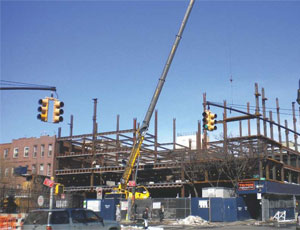Construction of the $14.9 million 360 Smith Street apartment building, sitting above the Carroll Street Subway Station in Carroll Gardens, Brooklyn, created some structural challenges for engineers and contractors.

“It was very complicated and very complex,” says Lance Franklin, a partner and CEO of Triton Construction of Garden City, N.Y., which expects to complete the project in June.
The site’s unique location in relation to the subway scared many developers away, but the location was ripe for development with the right structural system.
“There’s not a lot of multi-unit housing in the area, and since it’s right over the subway, you can come out the front door and walk under the building [to catch a ride],” Franklin says.
The first floor of the building contains parking and retail space, with 43-units above. The exterior features window walls, stucco and brick.
Ninety-two battered piles, drilled into a 20-ft to 30-ft wide area to the side the subway support the 75,000-sq-ft, seven-story building. A 5-ft high reaction mass is anchored to the top of the piles. Transfer beams shift the load through the building, so no load exists atop the subway.
Wexler & Associates of New York engineered the structure. Wexler and Triton used three-dimensional modeling to calculate the exact location of each pile and needed to relocate 10% of the piles to avoid conflicts.
“As intriguing as it sounds, it was equally intriguing to get it designed and approved with the transit authority engineers,” says Neil Wexler, founder of Wexler & Associates.
Triton excavated and exposed the entire subway, after removing a parking lot. Triton began installing the piles in 2008, when New York developer Billy Stein owned the site, but the job was stopped due to the economy, Franklin says. Work resumed in August 2009 under the ownership of the Gershon Co. of New York
Throughout the project, Triton monitored columns throughout the subway station for vibration. After installing the piles, the company poured a 24-in reinforced concrete slab up and over the subway. During that work, the station was closed.
“The entire steel structure sits on isolation pads, which will not allow the subway to vibrate up through the steel,” Franklin says. “The steel structure floats on top of the subway. There are snubbers that allow the building to move.”
The rubber, steel plate and specially designed Teflon isolation pads are about 5.5-in high and aim to serve three functions—seismic isolation, noise isolation and ground-vibration isolation. Track imperfections can cause vibration.
“You don’t want to sleep in a bedroom where a subway noise is being transmitted,” Wexler adds. “The isolation pads prevent vibration from entering the building.”
Key Facts
Project Cost: $14.9 million
Owner: Gershon Co., New York
Contractor: Triton Construction, Garden City, N.Y.
Architect: KSQ, White Plains, N.Y.
Structural Engineer: Wexler & Associates, New York

Post a comment to this article
Report Abusive Comment